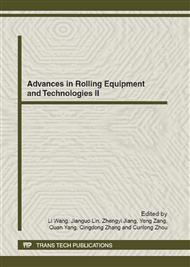p.1
p.7
p.13
p.19
p.25
p.31
p.37
p.43
p.49
Hot Strip Tail Flick Recognition Based on Morphological Pattern Spectrum
Abstract:
Hot strip tail flick is an abnormal production phenomenon, which brings many damages. To recognize the tail flick signals from all throwing steel strip signals, a feature extraction method based on morphological pattern spectrum is proposed in this paper. The area between signal curves after multiscale opening operation and the horizontal axis is computed as the pattern spectrum value and it reflects the geometric information differences. Then, support vector machine is used as the classifier. Experimental results show that the total correct rate based on pattern spectrum feature reached 96.5%. Compared with wavelet packet energy feature, the total correct rate is 92.1%. So, the feasibility and availability of this new feature extraction method are verified.
Info:
Periodical:
Pages:
25-30
Citation:
Online since:
October 2012
Authors:
Price:
Сopyright:
© 2012 Trans Tech Publications Ltd. All Rights Reserved
Share:
Citation:


